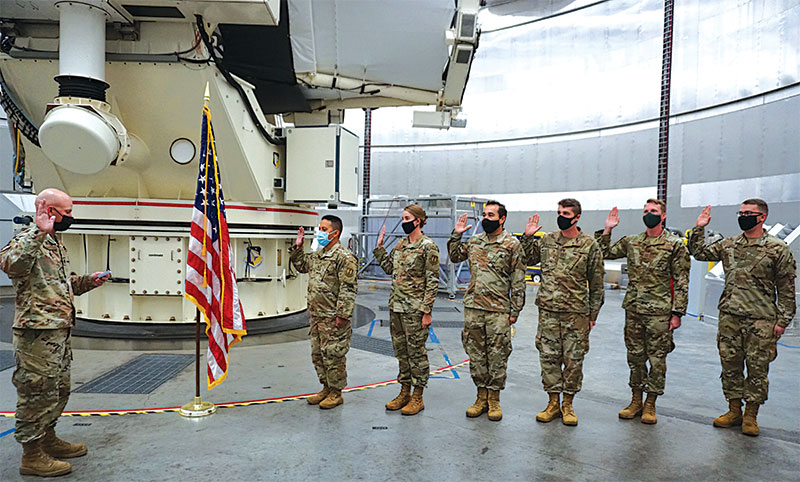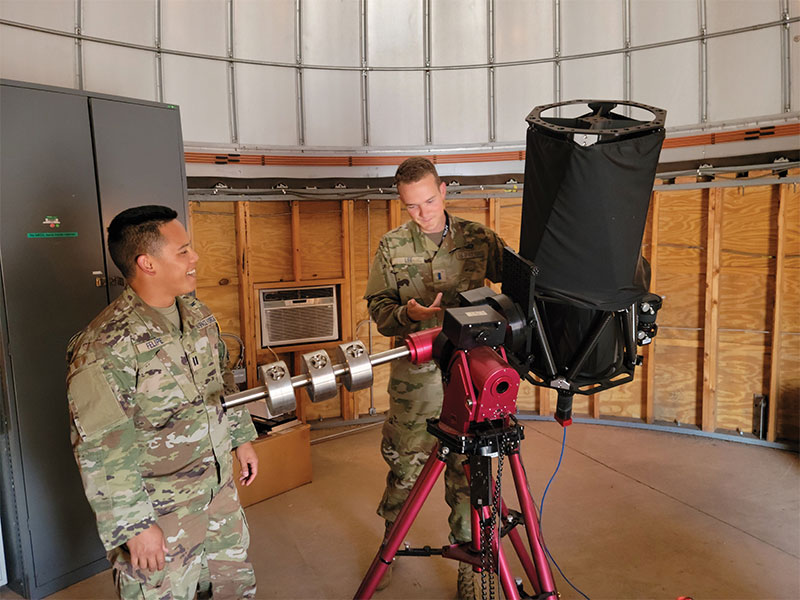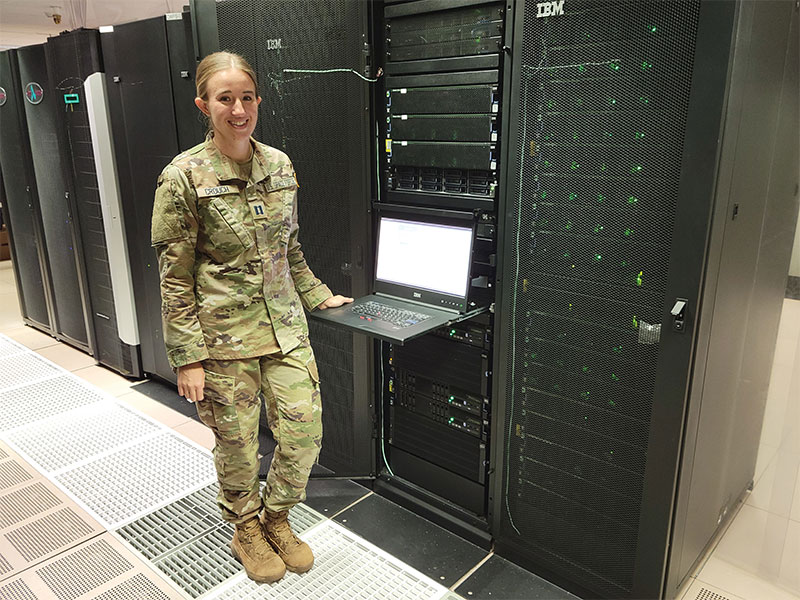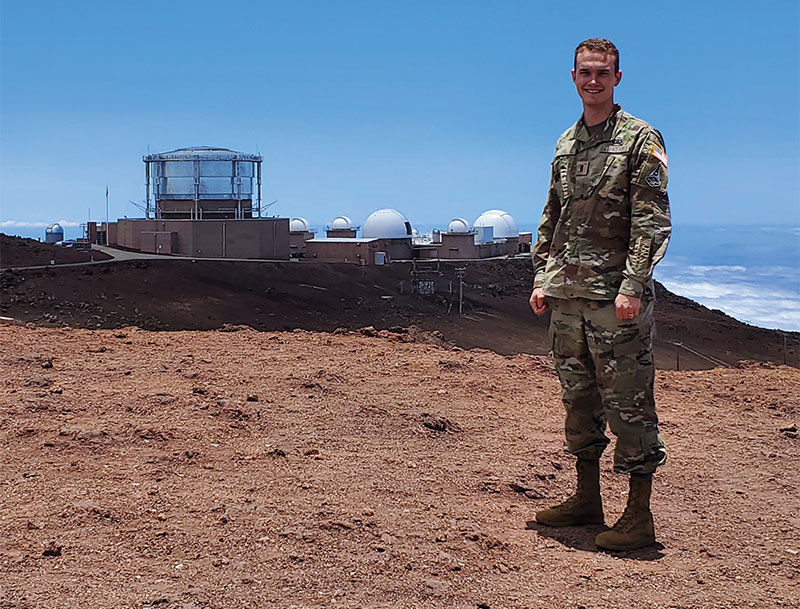The Force Is With Them
With the help of Guardian Capts. Cody Felipe and Tara Crouch, and 1st Lt. Justin Lee, the U.S. Space Force on Maui diligently provides strategic capability to the nation through telescoping and computing prowess.
The force is with Capt. Cody Felipe these days, and it shows.
The Pukalani native is among a group of officers assigned to the Air Force Research Laboratory’s Optical and Supercomputing Site on Maui. More importantly, he’s one of the pioneering members of the U.S. Department of Defense’s newest military service branch — the Space Force Guardians.
Being a Guardian on the Valley Isle represents a special homecoming for Felipe, who serves as the site’s installation and facilities chief.
“When I heard of the opportunity to go over to the Space Force, I thought it was good for me. It just made sense, because my career so far revolved around space systems,” explains Felipe, who started off at Vandenberg Air Force Base in Santa Barbara, California, where he performed space operations, before he eventually made his way to the Space and Missile Systems Center in Los Angeles.
Now, he’s back home and eager to see what life as a Guardian is all about.
“I’m very excited to be part of the new force and being close to my family again for a little bit before my next assignment, wherever that may be,” he says, adding that he’d also love to use his time on Maui to “strengthen ties with the community.”
One of three children born to Michael and Vangie Felipe, the 31-year-old serviceman comes from a family that has definite ties to the military. Most notably, he has uncles who have served in both the Navy and Army. However, he’s the only one to have joined the Air Force, and now the Space Force as well.
His family has expressed support for his career choice.
“They’re proud, they’re excited, and they can’t wait to see what the future has in store,” he says.
For Felipe and fellow Space Force Guardians and Valley Isle residents 1st Lt. Justin Lee and Capt. Tara Crouch, their mission is to protect U.S. and allied interests in space, and provide capabilities to the joint forces. Created in 2019, the United States Space Force was established within the Department of the Air Force.

Lt. Col. John Zingarelli, commander of Detachment 15, commissions (from left) Capts. Cody Felipe, Tara Crouch, Christopher Coury, Zachary Funke, Samuel Crouch and Braden Smith during a U.S. Space Force swearing-in ceremony Feb. 1 at the summit of Haleakalā. U.S. AIR FORCE PHOTO, COURTESY JOSHUA JOHNSON
Lee, 28, is a research engineer from Pocatello, Idaho.
“I lived there most of my life, but I ended up joining the Air Force, because while I was on a church mission in Portugal in the Azores, that’s where I had my first real Air Force experience and got to know a lot of the American Air Force families that were out there. I got to talk to them, and they really liked it,” Lee reminisces.
After returning the U.S., a motivated Lee decided to become a member of the Air Force.
“I was studying electrical engineering at the time. I joined the program and became an active duty member while I finished my schooling, and commissioned as an officer when I finished,” Lee shares.
Lee’s first assignment took place in Ohio at Wright-Patterson Air Force Base, where he served at the National Air and Space Intelligence Center.
“That was my first experience where I learned quite a bit about space and I found that I had a pretty significant interest in it,” Lee explains.
Next, he went to the Air Force Institute of Technology, a graduate school also located on the grounds of Wright-Patterson. He earned a degree in electro-optics, with a focus on telescope imaging and processing.
“At that point, once there was an option to transfer over to the Space Force, I was really excited to do that. To see that there was this new service that was dedicated completely to space — it just made perfect sense to join it. At that point, I was guaranteed to be able to work in space-related fields from then on,” Lee emphasizes.
“Our mission hasn’t really changed at all since we separated into our own service from the Air Force, but it adds the flexibility to grow and adapt as the threats change,” he notes.
Meanwhile, Crouch, also 28, plays a pivotal role as the Maui High Performance Computing Center program manager.
Crouch attended Iowa State University, where she participated in the Air Force Reserve Officer Training Corps and graduated with a bachelor’s degree in aerospace engineering. The AFROTC paid for her college tuition and she commissioned into the Air Force as an officer. Next, she attended the Air Force Institute of Technology and earned a master’s degree in aerospace engineering. She started off working in the field of acquisitions before she got the opportunity to transfer to the Space Force.
“I felt like I could make the greatest contribution to our national defense through the Space Force, because that’s where my technical knowledge was mostly accumulated in,” Crouch explains.
“Space has grown into its own service and is more important in the political domain,” she adds.
Crouch and her husband, Capt. Samuel Crouch, met at Iowa State University, where he also studied aerospace engineering. Both of them transferred over together to the U.S. Space Force during a swearing-in ceremony held Feb. 1 at the summit of Haleakalā, where the site’s telescope operations take place.
Crouch notes that the Maui site consists of two facilities that conduct operations, research and development. The first is the Maui Space Surveillance System, which uses telescopes, optics and sensors to collect images and data. Meanwhile, the second component is the Maui High Performance Computing Center.
While Crouch is employed at the supercomputing site, her husband works at the Maui surveillance telescope.
“We won the jackpot. It’s amazing here being with my husband … we’re in the same unit together, but not day-in-and-day-out together,” Crouch says.
The Space Force mission on Maui is two-fold — the telescope at Haleakalā and the High Performance Computing Center, Crouch elaborates. The Guardians also explain that Haleakalā has one of the best viewing conditions for their telescopes.
In addition, of the five U.S. Department of Defense supercomputing sites, the one on Maui is the only one west of Mississippi. Crouch adds that the 3.6-meter, 75-ton telescope is also the largest within the DoD.
Crouch also notes that the Maui High Performance Computing Center works with University of Hawai‘i to operate the center, adding that it has been a longstanding relationship for decades. This includes a four-year, $75 million contract signed last year between UH and the U.S. Air Force Research Laboratory.
“The University of Hawai‘i has core research areas that the Department of Defense has determined to be strategically important,” according to Crouch. “They provide so much good research for us and it’s really a great way to connect our site to the community here in Maui and to Hawai‘i at large.”
For Felipe, members of the Space Force have a responsibility to continue to educate the public about who they are.
“A lot of people don’t really understand that yet, but I think it’s our duty to do that and I think we will also be good role models for the kids who are interested in space-related things, keeping them engaged through a lot of the STEM outreach that we have,” he emphasizes.
“It gives them a better perspective of what we do here and the type of mission that we offer.”









